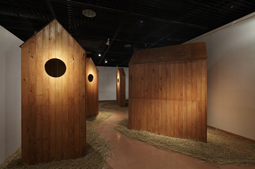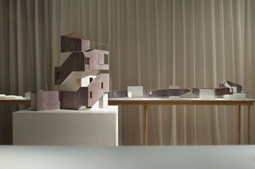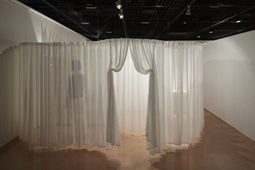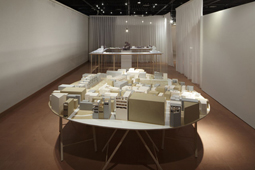 |
|
 |
| Yusuke Omuro, "The cabins" |
|
Maki Onishi, "Double Helix House" |
The Art & Architect Festa (AAF) is a Kyoto-based nonprofit organization established in 2010, with an executive board comprising architecture professors from various universities, led by Osaka architect Kohki Hiranuma. Intended to provide opportunities for artists, architects, and other specialists -- primarily graduate students -- to work on projects that directly address social and environmental issues, the AAF is engaged in producing exhibitions, workshops, and symposiums.
Last month the AAF held "U-30: Under 30 Architects exhibition" at the Design Gallery in the Osaka Design Promotion Plaza (an organization based in the Asia and Pacific Trade Center that provides business and technical support to newly established designers). Curated by Kikumi Furukawa, a member of Hiranuma's office, the exhibition showcased the work of architects still in their twenties. Furukawa selected seven individuals or teams: Yusuke Omuro (atelier Ichiku), Yusuke Fujita (Camp Design Inc.), Maki Onishi (onishimaki + hyakudayuki), Takashi Yonezawa (HAP + associates), Shuzo Okabe (upsetters architects), Shingo Masuda + Katsuhisa Otsubo, and Hiroshi Nishiyama + Keiko Okudaira (nishiyamahiroshiokudairakeiko).
Yusuke Omuro, a graduate of Tama Art University who spent two years working for Arata Isozaki, installed a full-size work titled "The cabins": four tiny plywood huts, each identical in profile but with depths that differ according to function. Yusuke Fujita, who established Camp Design in 2009 after working for two years at Tezuka Architects, contributed "Bare Room, Drop of city," a model of a hypothetical city comprising a table covered with volumes representing buildings, some of which are his own designs -- a mixture of realized projects and others that are still underway.
Maki Onishi completed her undergraduate studies at Kyoto University in 2006 (her thesis design project received third prize in the national competition for architecture graduates that same year) and is currently enrolled in the PhD program at Tokyo University. Her exhibit includes a model of "Double Helix House," a real commission, together with some theoretical proposals elaborating the same basic idea of a tubular space coiling around a rectangular volume.
Takashi Yonezawa, who started his office while still a student at the Nagoya Institute of Technology, has created an installation titled "noren" (the name for the small fabric curtain at the entrance to a traditional shop). It consists of hundreds of strings hanging from the gallery ceiling, their differing lengths cumulatively defining a set of ambiguous spaces. Yonezawa's project is nicely complemented by the adjacent installation from Shuzo Okabe, titled "TRAIL": a carpet of tall plastic fibers that were progressively crushed and flattened by exhibition visitors walking across them. Okabe completed a Masters degree in environmental design at the Graduate School of Media and Governance at Keio University and now runs an interdisciplinary office called upsetters architects, which aims to "observe the city and re-construct the cityscape."
 |
|
 |
Takashi Yonezawa, "noren"
|
|
Shuzo Okabe, "TRAIL" |
Shingo Masuda and Katsuhisa Otsubo, who have been working together and in collaboration with other designers since graduating from university, contributed "Sun Behind the Shade" -- sectional models of a building in which double-layered walls block the window openings, admitting soft light but blocking views in and out.
Hiroshi Nishiyama and Keiko Okudaira began working together while still students at Kobe Design University, where they studied under Akira Suzuki, an architecture critic who has long promoted "building literacy" -- the notion that any person should be able to build their own shelter should the need arise. Titled "in the curtain," their installation comprises a collection of small, irregularly shaped spaces partitioned by diaphanous white curtains, in part a full-size reproduction of their own home-office environment.
Graduating into a seriously depressed economic situation, these young architects are working with the humblest of materials and methods, and presenting themselves with a similar degree of humility and self-effacement, right down to the affected preference for lowercase office names. There is an instructive comparison to be made with those architects who graduated twenty years earlier into another economic downturn, the aftermath of the collapse of Japan's bubble economy. Finding themselves with very little real work, the so-called "Bow-Wow generation" (a label coined by Akira Suzuki) looked outward, making an unflinching examination of the existing city, both physically and functionally. By contrast, this current generation is tending to look inward at the fundamentals of architecture itself, making increasingly subtle and delicate examinations of the potentials of spatial, material, and lighting effects.
 |
|
 |
Shingo Masuda + Katsuhisa Otsubo, "Sun Behind the Shade"
|
|
Hiroshi Nishiyama + Keiko Okudaira, "in the curtain" |
 |
|
 |
| Yusuke Fujita, "Bare Room, Drop of city" |
|
Gallery entrance
Photography: Satoshi Shigeta
© Nacása & Partners Inc.
|
|